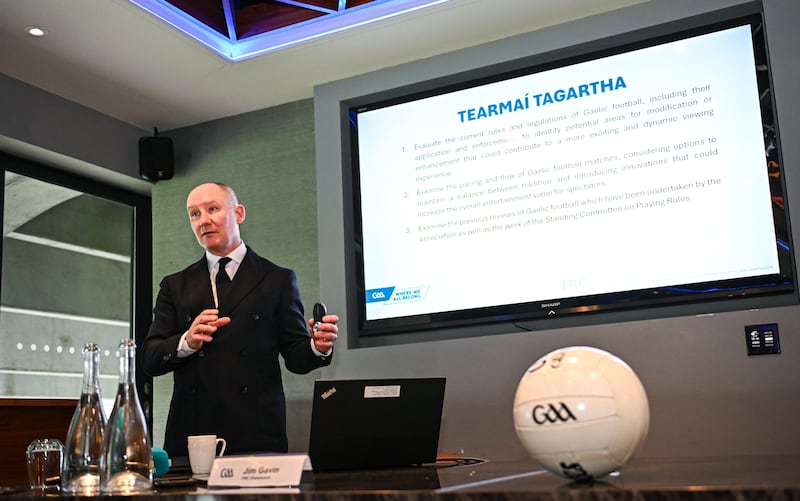Pádraic Joyce will be one of four high-profile managers taking charge of the teams for the Football Review Committee’s interprovincial series later this month.
Galway boss Joyce will be managing Connacht for the one-off Railway Cup revival tournament at Croke Park across Friday, October 18th and Saturday, October 19th, which is being used to further road-test the FRC’s rule enhancements ahead of Special Congress at the end of November.
Cork manager John Cleary will be at the helm with Munster, former Westmeath boss Dessie Dolan will be looking after the Leinster footballers while Fermanagh manager Kieran Donnelly will take the reins of Ulster.
The appointment of four distinguished intercounty managers adds more substance to a rules experiment programme already driven by a heavyweight committee fronted by Jim Gavin, which also includes Michael Murphy, Eamonn Fitzmaurice, Malachy O’Rourke, Colm Collins and James Horan.
RM Block
The semi-finals on October 18th are provisionally scheduled to throw-in at 6pm and 8pm, though those times are yet to be finalised. Saturday’s shield final is due to start at 5.30pm, followed by the cup final at 7.30pm.
The games will be open to the public and tickets are to be favourably priced at €15 for adults and €5 for juveniles, with one ticket permitting access to all four games over the two days.
It had originally been planned that all four matches would also be televised live, with TG4 broadcasting the Friday matches and RTÉ showing the Saturday offerings. However, scheduling difficulties may yet force TG4 to show just the second of Friday’s two semi-finals live, as the provisional throw-in times clash with the station’s daily Nuacht bulletin at 7pm.

TG4 could yet broadcast delayed coverage of the first semi-final, though a possible tweak to the fixtures could yet be made to facilitate a solution.
RTÉ will show both games live on the Saturday, with RTÉ News carrying the 5.30pm match and RTÉ1 showing the 7.30pm game. A clock-hooter system is also to be operational over the two days.
It is quite the accomplishment for the GAA to secure live television coverage of what are essentially trial games to road-test proposed new rules for Gaelic football.
RTÉ were scheduled to cover club championship matches that Saturday but Montrose officials have altered their plans and will now show the Croke Park matches.
“RTÉ were due to do club games that night anyway but, given the scale and scope of the proposed rule changes, have moved the club outside broadcast to Croke Park instead. Please note that these are not additional games,” read a statement from RTÉ.
The FRC has already held several sandbox matches around the country ahead of the interprovincial series.
There are over 20 various enhancements to be trialled but below are the seven core changes that will be examined:
40-METRE SCORING ARC AND ALTERED SCORING SYSTEM
A new 40-metre scoring arc would be introduced, where a ball kicked over the crossbar on or outside of the arc would be worth two points. Converted 45s would still be worth one point. All goals would be worth four points. The rationale behind these enhancements is to encourage long-range efforts while simultaneously incentivising teams to create more goalscoring opportunities.
KEEPING THREE OUTFIELD PLAYERS INSIDE THE 65
Probably the proposal that has generated most debate – this rule would require both teams to always have a minimum of three outfield players inside each 65-metre line. If a player in possession crosses the 65 and leaves just two team-mates inside then a free would be awarded to the opposition. The idea behind the proposal is to limit the chances of player saturation clogging up the scoring zone and instead create more space for the attacking team. It should also encourage fast counterattacks.
SOLO AND GO
The introduction of a solo-and-go option, where a fouled player has the option of continuing to play on rather than stopping to take a free. It is essentially a tap-and-go situation, to help speed up the game and reduce the number of stoppages for frees.
ONE V ONE THROW-IN
Rather than having four players contesting the throw-in at the start of the game and at the start of the second half, the referee would instead begin the match by throwing the ball in among two players – one from each team.
LONGER KICK-OUTS
Kickouts, all taken from the 20-metre line, would have to travel outside the new 40-metre arc. Players would be allowed remain inside the 20-metre line so as to allow the goalkeeper get quick kickouts away. If any opposition player interferes with the kick out or intercepts the ball inside the 40-metre arc, the ball would be brought forward 50 metres.
LIMIT BACK-PASSES TO THE GOALKEEPER
Players would only be permitted to pass the ball to their goalkeeper if both are inside the large rectangle or if the goalkeeper has pushed out beyond halfway.
ADVANCED MARK
To adapt the polarising rule of the advanced mark by decreeing the kick from outside the 45-metre line can only be claimed as a mark if caught inside the 20-metre line. And there would also be an advantage element added should the player opt to continue playing rather than pause to kick a mark.
- Sign up for push alerts and have the best news, analysis and comment delivered directly to your phone
- Join The Irish Times on WhatsApp and stay up to date
- Listen to our Inside Politics podcast for the best political chat and analysis




















